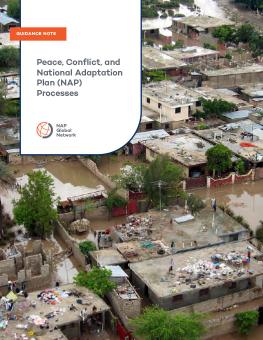
Peace, Conflict, and National Adaptation Plan Processes
Many conflict-affected states are also among the most vulnerable to climate change. The NAP process offers a chance to break this cycle.
-
Many conflict-affected states are also among the most vulnerable to #ClimateChange. The NAP process offers an opportunity to break this cycle. Learn more in our new guidance note.
-
#ClimateChange adaptation and peacebuilding go hand in hand. Our report provides strategic steps to kickstart climate adaptation planning in a way that responds to peace & conflict dynamics.
-
How can conflict-affected countries make links between #ClimateChange adaptation plans and peacebuilding as they grapple with pressing issues? Learn more about this crucial intersection here.
For states experiencing conflict, climate change adaptation is rarely, if ever, an immediate priority: issues such as national defence, the prevention of further loss of life and suffering, and the establishment of peace take precedence. In countries recovering from conflict and violence, where peace—however fragile—has been established, governments are often faced with the difficult, lengthy, and complex task of strengthening and rebuilding the governance mechanisms and institutions required to meet the immediate needs of their population and to protect them from a host of risks, including the return of violence. As in situations of active conflict, prioritizing climate change action in peacebuilding contexts can be difficult.
However, the close links between climate change and fragility mean that it would be a mistake to ignore medium- and long-term adaptation needs in these peacebuilding contexts.
This guidance note examines how governments operating in peacebuilding contexts can initiate, finance, implement, monitor, evaluate, and learn from their NAP process in a way that understands and responds to peace and conflict dynamics. The resulting conflict-sensitive NAPs are aligned with a country’s peacebuilding and development objectives, actively promote peace, and work to minimize the risks that climate change and adaptation programming will contribute to conflict. The guidance note’s three primary objectives are as follows:
- to outline the enabling factors required to design conflict-sensitive NAPs, namely leadership; data, knowledge, and communications; financing; institutional arrangements; stakeholder engagement; and skills and capacities;
- to offer practical entry points to design NAP processes whose main phases are aligned with peacebuilding objectives;
- to provide examples of how countries are integrating conflict and peacebuilding considerations into their NAP processes.
You might also be interested in
Border Carbon Adjustments: Trinidad and Tobago country report
This report consolidates, analyzes, and presents views and perspectives of stakeholders from Trinidad and Tobago on border carbon adjustment (BCA) schemes to contribute to the global debate on BCA good practices.
Estimate of Natural Infrastructure Public Grant Funding in Canada and in the Canadian Prairies
This analysis estimated the amount of public grant funding available across Canada and in the Canadian Prairie provinces for investing in urgently needed natural infrastructure.
Rethinking Investment Treaties
International investment treaties and their investor–state dispute settlement (ISDS) system are facing growing scrutiny. But what would an alternative system—one fit for the challenges of the 21st century—look like?
Global Dialogue on Border Carbon Adjustments: The case of Brazil
This report consolidates, analyzes, and presents the views and perspectives of stakeholders from Brazil on border carbon adjustment (BCA) schemes to contribute to the global debate on BCA good practices.